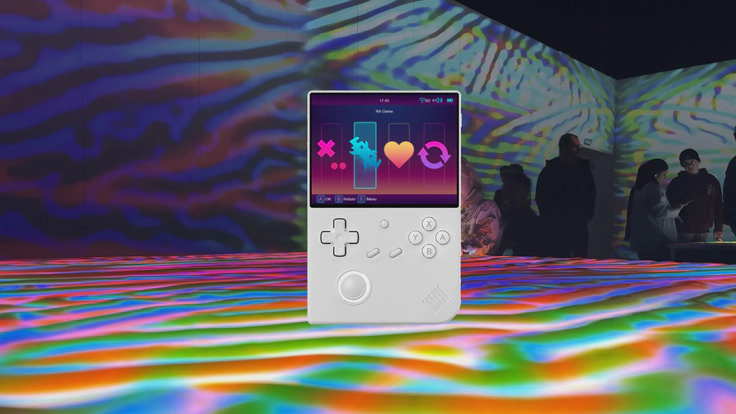MuOS on Anbernic Handhelds
Is MuOs for you? Everything you need to know (incl. setup guide for Mac)
 MuOs and a cool image from an art show I visited last year
MuOs and a cool image from an art show I visited last year
The stock OS on Anbernic devices leaves much to be desired. This is often the first thing fans of these devices replace, along with the micro SD card, which frequently turns out to be of poor quality.
In this guide, we dive deeper into MuOS: its pros and cons, how to install it, and how to put games/ROMs on your device.
Table of Contents
- What is MuOS (MustardOS)?
- Supported Devices
- Who is MuOS for?
- Is it any good?
- Installation, BIOS, and Adding ROMs to Your Device
What is MuOS (MustardOS)?
- Custom Firmware: MuOS is an alternative operating system specifically developed for retro gaming consoles, such as the Anbernic RG35XX.
- Improved Performance: It offers optimizations like faster load times, better emulation performance, and a smoother interface experience.
- Extra Features:
- More configuration options for emulators.
- Support for a broader range of games and ROMs.
- Modern features like save-states, shaders, and more.
- Community-driven: This firmware is maintained by an enthusiastic team of developers.
Supported Devices
As of this writing, MuOS supports the following Anbernic devices:
- RG28XX
- RG35XX H
- RG35XX Plus
- RG35XX-2024
- RG35XX-SP
- RG40XX H
- RG40XX V
Don’t have a retro emulation handheld yet? Check out my webshop RetroGear.nl.
For the latest list of supported devices, check the official website.
Who is MuOS for?
MuOS is perfect for retro gaming enthusiasts who want to upgrade their Anbernic console, such as the RG35XX, for a smoother and more customizable gaming experience. It’s ideal for users who want to overcome the limitations of the stock firmware and benefit from faster performance, enhanced emulator functionality, and a user-friendly interface. Thanks to its active community, MuOS provides regular updates and support, making it a must-have for anyone wanting to get the most out of their handheld gaming console.
Is it any good?
Although I personally prefer KnulliOs, MuOS is definitely a solid choice. One major advantage over KnulliOs is the ease of adding ROMs and BIOS files to your SD card. With KnulliOs, this setup requires a bit more effort since you need to upload these via Wi-Fi.
I recommend MuOS for gamers who want a custom OS but prefer less complexity. Another benefit of MuOS is that it is almost fully configured right out of the box.
A downside compared to KnulliOs is that it has fewer tools. For example, on KnulliOs, you can easily scrape game data, such as images and videos, and set timers for these processes.
Installation, BIOS, and Adding ROMs to Your Device
Do you already have an SD card with MuOS on it? Skip to step 7.
Note: This guide is written for Mac users. For Windows users, I recommend reproducing the steps. I’ll update this guide in the future to support Windows as well.
Step 1: Download the MUOS Image
- Download from: https://muos.dev/release/current
- Choose the correct version for your device. In this case, I’m using the version for the Anbernic RG40XXV, but this guide works fine for an RG35XXSP, etc.
- Extract the file:
- On Mac: Double-click the file.
- On Windows: Use a tool like 7zip.
Step 2: Insert the SD Card
Insert the SD card into your Mac via an SD card reader. Make sure you know which disk the SD card represents.
Step 3: Identify the Correct Disk
Open the terminal and run the following command to see all connected disks:
diskutil list
Find your SD card in the list (e.g., disk2) and note it. Make sure you select the correct disk, as the next process will erase all data on it.
Step 4: Format the SD Card to FAT32 (Mac Terminal)
To format the SD card to FAT32 on a Mac, follow these steps:
-
Use the following command to format the SD card to FAT32:
diskutil eraseDisk FAT32 MUOS MBRFormat /dev/diskXReplace
diskXwith your SD card’s device ID (e.g.,disk2). -
In this example, the disk is renamed to MUOS and formatted with a Master Boot Record (MBR).
-
Verify that the SD card is correctly formatted with:
diskutil info /dev/diskXEnsure the filesystem is FAT32.
Step 5: Unmount the SD Card
Unmount the SD card without physically removing it:
diskutil unmountDisk /dev/diskX
Replace diskX with your SD card’s name (e.g., disk2).
Step 6: Write the MUOS Image to the SD Card
Use the dd command to write the image to the SD card:
sudo dd if=/path/to/muos-image.img of=/dev/rdiskX bs=1m status=progress
- Replace
/path/to/muos-image.imgwith the full path to the MUOS image file. - Replace
rdiskXwith your disk name. Example:
sudo dd if=/Users/Jorne/Downloads/muOS-RG40XX-V-2410.2_BIG_BANANA-84829a15.img of=/dev/rdiskX bs=4M status=progress && sync
Enter your password if prompted.
Step 7: Install on Your Device
Insert the SD card into your Anbernic device and turn it on. The installation process takes about 7-8 minutes.
Step 8: Add ROMs/Games to the SD Card
- Download ROMs only from trusted sources. Check out Itch.io for cool new games — most are free to download, but you can also choose to support the developers with a donation. Itch.io Sort your ROMs into folders (e.g., SNES games in an SNES folder). Move the folders to the ROMS folder on your SD card.
Step 10: Play Games on Your New Custom OS
Insert the SD card into your Anbernic device and turn it on. Go to Explore Content to view and play your games.
Step 11: Choose a Cool Theme
Check out https://muos.dev/themes and choose a theme. Download the zip file and place it in:
MUOS/theme
Select the theme via Configuration > Customization > MuOS Themes.
Step 12: Go Outside and Shout “Thank You, Jorne!!!!!!”
Just kidding, don’t do that… but…
If this post has helped you, I’d really appreciate it if you shared it with friends or acquaintances. And if you’re still looking for a Brick, MM+, or another retro device, check out my webshop retrogear.nl.
-XXX-
Jorne

